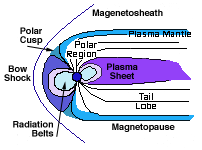The Plasma Sheet
The plasma sheet is a thick layer of hot plasma centered on the tail's equator, with a typical thickness 3-7 RE, density 0.3-0.5 ions/cubic cm. and typical ion energy of 2-5 keV.
Unlike the inner magnetosphere, this region is rather dynamic: thickness, density and energy vary greatly, and the plasma often flows rapidly in various directions, particularly earthward. In "substorms" some parts of the plasma sheet may get "squeezed out" earthwards and tailwards: earthward-flowing ions gain energy and penetrate the inner magnetosphere, while the outward moving sections ("plasmoids") stream away from Earth and are lost.
The plasma sheet, too, has its associated electric current, flowing across the tail's equator from flank to flank, from east to west ("dawn to dusk"). It then closes along the magnetopause, and the magnetic field created by this circuit helps stretch out the tail lobes (below).
The Tail Lobes
The tail lobes are two regions of relatively smooth magnetic field, north and south of the plasma sheet. Field lines of the lobes are smooth, and maintain roughly the same direction until they converge above the poles. They point towards Earth north of the equator and away from Earth south of it.
This region is almost empty of plasma--typical density 0.01 ion/cubic cm., the "best vacuum" in the Earth's vicinity--but it contains a relatively strong magnetic field which, since it fills a large volume, can store appreciable magnetic energy, Many believe that this is the storehouse from which substorms draw their energy, releasing it quite rapidly. Further down the tail the plasma density increases, as ions from the boundary layers infiltrate the lobes.
Other Regions and Particles
Boundary layers are observed at times just inside the magnetopause, their thickness is generally less than 1 RE. They mark a transition between regions, and their plasma density is intermediate between that of the magnetosphere and the solar wind (e.g. 2-3 ions/cubic cm). Their ions seem to come from both of these sources, and their field lines sometimes seem to be connected to the IMF.
All the above plasma particles are fairly energetic. There exists in addition low energy plasma from the ionosphere, rotating with the Earth, and extending to about 4-6 RE with a density that gradually diminishes from up to 1,000,000 per cubic cm at an altitude of 200 km to about 10 at the outer limits.
Finally, a large cloud of neutral hydrogen surrounds the Earth, the "geocorona" (click here for its picture). Since particles in space collide so rarely, these different populations can co-exist with relatively little interference.
All these regions have been visited by satellites, and a fair amount is known about their average properties. However, their detailed structure and the way they vary with time are only poorly known, because their features (like weather) keep changing, and only a few isolated satellites are usually available to track such changes. Imagine studying the weather with only a few isolated observatories! A great deal of ingenuity has been applied in the past to exploring the Earth's magnetosphere, but the greatest need is now for many more simultaneous and coordinated observations in the various regions of earthspace.
For a fold-out paper model of the magnetosphere, link here.
Questions from Users:
***
A working model of the magnetosphere?
*** Risks of Spaceflight: Fry or Freeze... ?
***
Mapping the magnetosphere using a surface network?
|

